|
The World's Fair of 1964-1965 was not an
official fair. The International Exhibitions Bureau (BIE), an
organization governing worldwide fair scheduling and participation
rules, did not approve New York's bid for several reasons. First,
it was not directly organized by the government, but was rather
a private non-profit corporation that was established with government
approval and without government funding. Second, it planned to
charge rent for foreign governments' pavilions in violation of
BIE guidelines. Third, its run was planned to last longer than
six months, which was the maximum time allowed by BIE rules.
Finally, it would be occurring within two years of the last American
World's Fair (Seattle, 1962), again running afoul of guidelines
that required ten year intervals between fairs in a particular
country.
These guidelines were put together at a
diplomatic convention of thirty-two nations held in 1928 in Paris.
Since the 1851 Crystal Palace Exhibition in London, Western nations
tried to emulate the accomplishment with fairs of their own.
As each successive fair strove to outdo its predecessors, the
Western world was inundated with creative attempts at exhibiting
industrial and artistic progress in each nation. The initiative
by fair organizers in Western Europe to regulate the frequency
of the fairs and the rights of exhibitors led to the Paris Convention
of 1928, which established the Bureau International des Expositions.
The United States was not involved in the
1928 Convention nor did it become a
member of the BIE. Joining would involve a Senate resolution
and the signing of a treaty by the President. Without popular
interest, these measures would be quite difficult to obtain,
and since World War I, the US was wary of international treaties.
Besides, fairs in the United States had historically been produced
by private, government-appointed commissions. The first American
fair, New York's Crystal Palace of 1853, was modeled after the
1851 London Fair. London's Crystal Palace had been a government
venture, as were most subsequent European fairs. The plans for
the New York Fair, on the other hand, were initiated by an auctioneer
from Massachusetts and a group of New Yorkers, including New
York Tribune editor Horace Greeley. The group managed to get
a lease from the city for the space that is today Bryant Park,
but that was the extent of government support for the Crystal
Palace. Due to the divisive national political climate in the
1850s, there was Southern opposition to funding the New York
event. The Fair was a financial and inspirational failure, although
it did establish the procedure for the private organization of
American fairs.16
Government antipathy towards fairs still
lingered in 1959, when New York was chosen by President Eisenhower
as the next American fair site. By August of that year, New York
Fair officials were foreshadowing the possibility of a conflict
with the BIE. Thomas J. Deegan, the chairman of the World's Fair
Corporation, regarded the opposition to New York's rule-breaking
a "slight diplomatic problem."17 He flew to Paris in October, shortly after
the announcement that New York would be the site of the next
American fair, but considered his visit to the BIE merely a "courtesy
gesture."18
Thomas J. Deegan, Jr., chairman of the Fair's
executive committee.
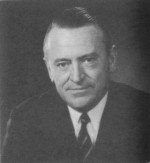 |
Seattle's 1962 Century 21 Exposition was
also organized by a government-commissioned private enterprise,
and both Seattle and New York organizers were well aware of the
advantages BIE recognition had to offer, even to non-member states,
such as the automatic endorsement of thirty mostly Western European
nations. Seattle's planners, though, chose to follow the rules
laid out by the BIE closely. The Fair was scheduled to run for
just six months, and it provided rent-free pavilions to foreign
nations. Organizers of the New York Fair felt, on the other hand,
that abiding by the BIE's rules would be impossible. "The
Fair must continue two years to justify the huge investments
amounting to $700 million, to accommodate the numbers anticipated,
and to provide sound financing." Nor could the Fair afford
to give away "a huge amount of free space." According
to Deegan, BIE approval was "desirable but not necessary."
The New York World's Fair was determined to run its own show.19
On November 8, 1960 both the Seattle and
New York proposals were considered by
the BIE in Paris. Twenty-seven of the thirty member nations were
present and the President, Leon Barety, presided over the meeting.
The Classification Committee of the BIE approved the Century
21 Exposition, and then discussed the New York World's Fair at
length. The issue was brought to a vote. Twenty-three countries'
delegations voted against endorsement of the New York World's
Fair and four abstained, including the USSR. The BIE's subsequent
press release stated:
After examining several projects
of international fairs currently contemplated in various countries,
the Council has decided to give the members of the Bureau a favorable
advice for their participation at the International Exposition
of second category in Seattle 1962. This decision excludes all
possibility of participation by a country member of the Bureau
in another exposition in the American zone during the period
of time described by Article 4 of the Convention of 1928.20
Seattle was the victor, and New York was
left to its own devices.
Seattle was the victor, receiving the official
blessings of the BIE to host the American World's Fair of the
1960s.*
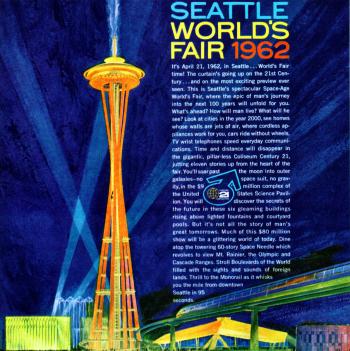 |
Genevieve Marechal, the Director of the
BIE, said afterward that the plans submitted to the BIE about
the New York Fair were "exceedingly skimpy," while
Seattle's plans were detailed and met all BIE conditions. The
ruling, said Marechal, was irreversible despite whatever pressure
she expected Washington might place upon the BIE. Seattle's organizers,
however, were "jubilant," because with BIE approval,
they did not need to worry about New York's Fair overshadowing
their own."21
Without the support of the BIE, member
nations were barred from participating in the New York Fair.
This meant that New York organizers had to mobilize to find private
sponsors who could gain government approval within these nations.
Pitched as a marketing tool and a chance to capitalize on an
event of an international scale for organizations and industries,
the Fair did appeal to some groups in countries such as France,
Sweden and Switzerland. But representation from some nations
was glaringly missing, including Great Britain, Canada, and Italy.
American public opinion was divided on
the issue. Some called for the United States
to consider membership in the Bureau in hopes of amending Bureau
protocol either for this Fair or at least for future US fairs.
Others suggested adjusting the goals of the Fair so that it would
act as an international university, which they felt would surely
receive endorsement by the Bureau. Newspapers reported that Fair
officials had appealed to President Kennedy to use his influence
to persuade first the BIE and then BIE member nations into participating
in the Fair.22
Officially, the World's Fair Corporation
presented itself as unconcerned with the matter of the Bureau's
ruling. However, it worked hard to ignore what was obviously
an embarrassment, or was completely antagonistic towards the
BIE. In training materials for the visiting teams of the IAE,
the spokesmen were instructed not to bring up the current BIE
resolution with foreign governments, but that if the matter did
come up, to refer to the undeterred success of the 1939 Fair
"with many foreign nations participating without the bureau's
approval."23 The Fair
also wanted to dispel any possibility of having the US join the
BIE. In a press release ten days after the vote, the Fair stated,
"Aside from the absurdity of operating a Fair here under
control and direction from a Bureau in Paris, there is no sentiment
here at this time for joining treaty organizations of this sort,
and a debate on this subject would surely do nothing to promote
peace and harmony." 24
While the Fair with Moses at its head was
content to turn its nose up at the BIE, what
the public did not know was that the Fair had been involved in
quiet negotiations with the BIE for US membership since the beginning
of Fair planning mid-1959. On Deegan's first trip to Paris to
meet with the BIE, he was accompanied by the Ad-hoc Inter-Departmental
Committee to Review the Subject of US Accession to the 1928 Convention.
The Committee consisted of members of the Department of Commerce,
Department of State, and the US Information Agency. The BIE had
been trying to get the US to join the Convention since 1939 when
New York held its last Fair. The BIE threatened to have its members
boycott that Fair, which broke the same rules, but Fair President
Grover Whalen bargained with the BIE, offering the membership
of the US after the end of the Fair in exchange for approval.
The BIE complied, and Whalen naturally did not see his promise
through, as he had no control over US accession. The Interdepartmental
Committee was created to finally begin working towards giving
the BIE the coveted participation of the United States. Leon
Barety had been President of the BIE since its creation, and
it was speculated that he wanted the US to join "as a crowning
achievement of his career and then retire."25
At first, the BIE was willing to revise
its charter to appease the United States. The BIE, in fact, was
very interested in having the US become a voting member of the
group by
the time the Soviet Union requested its proposed 1967 Moscow
fair be approved. The French leaders of the BIE favored a fair
in Canada that year, and needed the US's Cold War influenced
vote to keep the Fair in the free world.26 Canada, on the other hand, knew that if
the US joined the BIE, the 1964 Fair in New York would be promised
to the US, thus competing with Canada's own fair only three years
later. (The 1967 Fair was eventually granted to the Soviet Union.)
The demands of the US and particularly of New York once Moses
came on board, coupled with the diplomatic controversies regarding
the US from inside the BIE, became too much for the BIE leaders
to work with, and negotiations fell apart.27
When the Soviet Union withdrew their application
to host the Universal and International Exposition of 1967, the
BIE awarded the Fair (expo67) to Montreal, Canada. This forced the New York World's
Fair to compete for funding, exhibits and visitors with two officially
sanctioned World's Fairs in North American within the span of
five short years.*
|

|
While the 1928 Convention convened in order
to regulate the proliferation of
international expositions "as a means of promoting international
goodwill," the 1964 Fair was determined to bring international
goodwill to Flushing Meadows without the help of such a governing
body.28 According
to Robert Moses, the President of the World's Fair Corporation,
the BIE was made up of "three people living obscurely in
a dumpy apartment" in Paris. Their rejection of the New
York Fair, he said, came from bitterness over Grover Whalen's
unfulfilled promises in 1939. "The Fair will go on without
them," said Moses.29
Moses had a reputation of antagonizing
his critics and detractors. The BIE controversy was one of the
first issues that led to major criticism of the New York World's
Fair in the American press, something that would continue until
the end of the Fair. Most of the controversies surrounding the
Fair had to do with Moses, who regularly lashed out at critics
and rejected advice. During the course of Fair planning, Moses
charged that anyone who opposed the Fair was helping to "encourage
the evil forces which divide our country." While Moses's
regular comments such as these were fuel for the press, they
were also incendiary words that provoked negative feelings amongst
the Fair, the BIE, and its member governments. Because of Moses's
comments, "instead of passive non-endorsement, the Bureau
of International Expositions became actively "hostile"
towards the Fair, said the New York Times.30
Inside the Fair, though, efforts to make
some semblance out of the BIE conflict was ongoing, and vital
to the health of the International Area. The World's Fair Directors
worked closely with the State Department. James Hurd of the Bureau
of Public Affairs was the first to break the news of the BIE
vote to the IAE. And even into 1961, the Fair was working hard
to keep foreign nations interested in participation. Allen Beach
of the IAE met with Hurd on May 9 at which time "all American
embassies in BIE countries received [a] dispatch…requesting
ambassadors inform BIE delegates further action against New York
[is] unnecessary."31
Charles Poletti, the Vice President of the Fair in charge of
the IAE, advised Moses, who was to meet with President Kennedy,
"to request the State Department to see in Washington the
Ambassadors of some of the principal countries which are members
of the BIE, and to put some pressure on them."32 The Fair still sought all the participation
they could get from the BIE countries.
Because of the BIE fiasco, the International
Area of the Fair was defined by a strong presence of newly independent
developing nations and "get rich quick entrepreneurs"
from the absent nations who privately sponsored pavilions to
represent them. Since few of these pavilion sponsors had much
experience with putting together an exhibit of such a large scale,
the Fair's International Division had its work cut out for it.
Allen Beach of the IAE expressed his concern for the "myriad
of problems that will arise" in the International Area of
the Fair. "Many of the expected participating nations, especially
the newly independent ones, are going to have to be led by the
hand, step by step."33
International Affairs and Exhibits Staff: (left
to right) Mr. Allen Beach, Director of Exhibits; Governor Charles
Poletti, Vice-President; Mr. Lionel Harris, Mr. Douglas Beaton,
Mr. Gates Davison.*
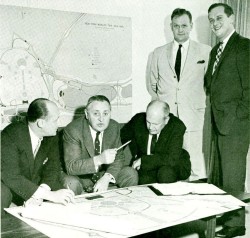 |
Beach's observation laid the groundwork
for the organization of the International
Division to consist of several directors, each responsible for
a group of exhibitors with whom they would work closely from
the time of the invitation to the Fair until the pavilion was
demolished. Beach was the Administrative Director of the IAE,
and he was the only professional career fair man on the staff.
The rest of the staff divvied up the regions of the world, and
each man reported to Charles Poletti, a former lieutenant governor
of New York who served as governor for twenty-nine days when
Herbert Lehman resigned early from the position in 1942 to work
for the Department of State. Poletti was a long-time colleague
of Robert Moses as a Trustee of the Power Authority of the State
of New York for which Moses had been Commissioner.
As a friend and close colleague of Moses,
Poletti was in an envious position. He was often recommended
for pay raises and exotic extended business trips, and he generally
acted according to Moses's personal theory of speaking one's
mind. Incendiary comments of his own lost the Fair participation
of at least one foreign country, and his threatening behavior
intimidated some of the members of his staff. Poletti's strong
personality both facilitated and endangered international participation
in the New York World's Fair.34
In addition to the difficulties of securing
foreign participation, the Fair also struggled to hold on to
government support. In September of 1961, Democratic Senator
Frank J. Lausche of Ohio announced he would block any Senate
resolutions to fund a Federal pavilion at the Fair. He then threatened
to kill a bill in the Senate which, if passed, would provide
$300,000 for a study into Federal participation. Backers of the
Fair estimated a $30 million expenditure for the Federal building
they had in mind. Lausche referred to the 1959 agreement that
if New York were chosen as the site of the Fair, the Federal
government would not be required to fund the event. The terms
of this agreement were put forth by New York Senator Jacob K.
Javits, when lobbying for New York to become the home of the
Fair.
Lausche gained some support for his case,
and the bill was killed. The matter then
became extremely frantic for the Fair planners. Moses feared
that if Congress did not get a Federal pavilion off the ground
during the current session, there would not be adequate time
to build a pavilion later. "It seems to us unthinkable that
there would be no Federal exhibit at the New York World's Fair,"
said Moses, which would be "a subject of reproach throughout
the United States and the entire world."35
Using New York politicians at its disposal,
the Fair began a campaign to obtain
Federal money. Moses and Javits attempted to persuade Lausche
to reconsider his position, pointing out that New York was not
asking for government funding but for a Federal pavilion to act
as a focal point "to emphasize the achievements of our country
and the major objectives and purposes of our democracy"
to the other participating nations of the world. New York Senator
Kenneth B. Keating suggested asking President Kennedy to subsidize
the study from his own emergency funds. Mayor of New York Robert
F. Wagner wrote an open letter to the President appealing for
"the assurance of Federal interest and support which will
guarantee the standing of the fair as an event to which all Americans
- in fact, all of the peoples of the world - will look forward
to…" Wagner's letter helped. Kennedy prepared a statement
expressing US interest in the Fair, and then agreed to set up
the study committee himself.36
President John F. Kennedy confers with Robert
Moses and Thomas J. Deegan, Jr. regarding Government participation
in the Fair. The President signed an appropriations bill of $17,000,000
for the Federal Pavilion in July, 1962.*
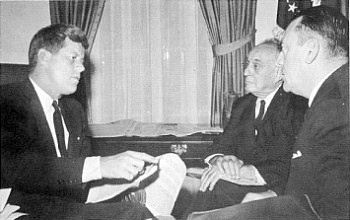 |
Even with this temporary resolution, the
dispute did not fade away. Instead it became a hot point of debate.
Javits wrote a lengthy article for the New York Times arguing
that the attempts to keep the US out of the Fair were the result
of an anti-New York attitude in Washington. Javits said that
no other Fair had such trouble obtaining a US pavilion, including
Seattle. "I do not think it is too much to expect our Federal
legislators to temper with more responsibility and national pride
their treatment of New York."37
Javits, a Republican, also criticized the
timing of Kennedy's support as a ploy to aid
Democrat Wagner in his re-election campaign. Moses agreed with
Senator Javits. Following a half-hour meeting with President
Kennedy on the same day that Wagner's letter to Kennedy was published,
Moses wrote to Deegan that "the Fair cannot be run from
city hall in the midst of a municipal campaign and on the basis
of politics. Our Washington relations with the administration
must be direct and wholly non-partisan."38 However, the fact that Moses would meet
with Kennedy himself about Fair funding or BIE issues did not
phase Moses in the least.
While it seems that those who involved
themselves in the dispute had various agendas in speaking out
for different sides, in April 1962 the Senate approved $15 million
for a Federal pavilion. A short-term "space race" with
the USSR for the largest pavilion, an encore from the 1939-1940
Fair, expanded the plans of the pavilion until the cost doubled
to $30 million by the time it was completed.39
Architectural model of the Federal Pavilion
for the 1964/1965 New York World's Fair.*
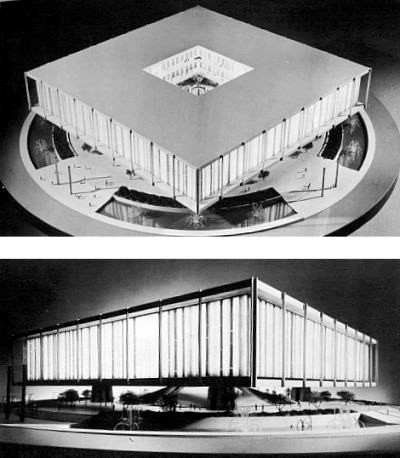 |
© Copyright 2005 Sharyn Elise Jackson, All Rights
Reserved.
|